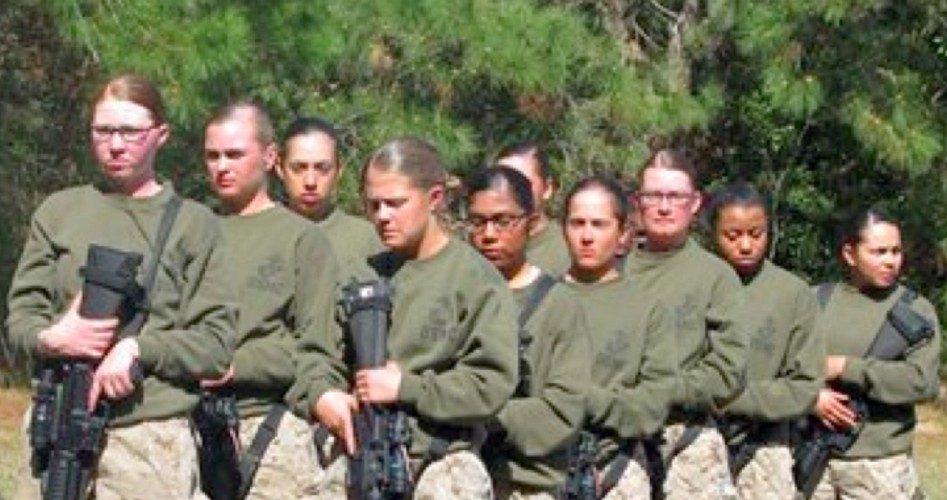
Nearly five months after U.S. Defense Secretary Leon Panetta announced that he would lift the ban on women military personnel serving in combat positions, the service branches said they are firming up their plans for implementing the controversial policy. The Associated Press reported that on June 18, the heads of the services laid out a blueprint that will phase women into fighting units and even special operations, with the Army Rangers beginning to train females by this time next year, and the Navy SEALS a year later.
AP reported that the plans include a review and possible change of the physical and mental standards men and women must meet to qualify for infantry, armor, commando, and other front-line fighting positions across the Army, Navy, Air Force, and Marines. Under the plan, Defense officials said, there would be one common standard for both men and women. “The proposals leave the door open for continued exclusion of women from some jobs if research and testing find that women could not be successful in sufficient numbers,” reported AP. “But the services would have to defend such decisions to top Pentagon leaders.”
Elaine Donnelly, president of the Center for Military Readiness, pointed out to One News Now that continuing with a high standard for combat was not what was being discussed earlier this year. “General Martin Dempsey … said in January that all standards will be questioned if they are ‘so high that a women couldn’t make it,’ using his words,” Donnelly recalled. She emphasized, however, that the “all-male units that we’re talking about today should remain all-male — that’s the only way to keep those standards high and commensurate with the demands of direct ground combat.”
In 1992 Donnelly was part of the presidential Commission on the Assignment of Women in the Armed Forces that determined by majority vote that women had no place in direct combat on land, in the air, or on submarines and amphibious vessels. As reported by The New American, a “summary within the ‘Alternate Views’ section of the commission’s report noted that in its intensive, eight-month study, the commission concluded that assigning women to combat would: 1) ‘adversely affect the critical components’ of combat readiness, unit cohesion, and military effectiveness; 2) ‘leave women exposed to the possibility of involuntary assignment to combat and conscription’; and 3) ‘overturn two centuries of settled law and military policy based on deeply held and commonly shared cultural assumptions defining how men should treat women.’” Most significantly, the exhaustive study confirmed to the majority of commissioners that “the military does not need women in [and] should not assign women to combat.”
Several months ago retired U.S. Army Lieutenant General Jerry Boykin, a combat veteran and former commander of the Army’s Green Berets special forces unit, offered his grave concerns over the move. “Women have been in combat since the United States began combat operations in Afghanistan in 2001,” noted Boykin, who serves as executive vice president of the Family Research Council. “They have fought and served with distinction. However, placing women in infantry and other front line units is a different issue and it has nothing to do with their courage or capabilities.”
Boykin argued that the special interests pushing for allowing women in combat are not attuned to the dangers and privations faced by infantry troops and special forces. “These units have the mission of closing with and destroying the enemy, sometimes in close hand-to-hand combat,” explained Boykin. “They are often in sustained operations for extended periods, during which they have no base of operations nor facilities. Their living conditions are primal in many situations with no privacy for personal hygiene or normal functions. Commanders are burdened with a very heavy responsibility for succeeding in their mission and for protecting their troops.”
Boykin warned that integrating women into such combat situations “places additional and unnecessary burdens on leaders at all levels. While their focus must remain on winning the battles and protecting their troops, they will now have the distraction of having to provide some separation of the genders during fast moving and deadly situations. Is the social experiment worth placing this burden on small unit leaders? I think not.”
The impending policy change comes on the heels of a revelation last month that sexual assaults in the military have skyrocketed 124 percent over the past 10 years. Significantly, with the repeal of the “Don’t Ask, Don’t Tell” ban on homosexuals in the military, more men complained of sexual assault against them by other men in 2012 that did women — 14,000 to 12,000.
According to the AP, earlier this year “Joint Chiefs of Staff Chairman Gen. Martin Dempsey said the sexual assaults might be linked to the longstanding ban on women serving in combat because the disparity between the roles of men and women creates separate classes of personnel — male ‘warriors’ versus the rest of the force.” Dempsey didn’t venture a reason as to why gay sexual assaults were on the rise also.
Photo: AP Images


